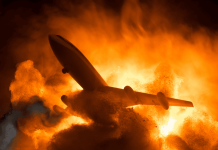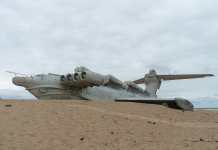China’s Xi’an H-6 bomber continues to be in the news for its ADIZ (air defense identification zone) transgression in the East and South China Seas. This old Chinese bomber has transformed into a cruise missile truck.
In July 2024, Chinese state-sponsored media showed pictures of the H-6K bomber taking off with four air-launched ballistic missiles, dubbed the YJ-21 by foreign media, an increase from the earlier capability to carry two since 2022.
It was further reported that the ballistic missile can hit stationary targets as well as slow-moving targets, including aircraft carriers, at hypersonic speeds from extended distances.
The H-6K wings appear to have been further strengthened. It can substantially increase the PLA Air Force’s (PLAAF) long-range precision strike capabilities in anti-access/area denial missions.
Chinese media is comparing the missile to Russia’s Kinzhal missile carried on the MiG-31. Though an old platform, China’s H-6 bomber remains viable and capable in the 21st century and seems ready to attack any possible target.
Time to understand the potency of this otherwise old bomber.
Forget J-20, China’s H-20 Stealth Bomber Threatens ‘Easy Penetration’ Of LAC; How Can IAF Respond?
World’s Operational Bomber Aircraft
Only the United States, Russia, and China operate bombers, and all three continue to develop newer ones. The United States is clearly ahead with its latest Northrop Grumman stealth B-21 Raider, which made its maiden flight earlier this year.
There are two major classifications of bombers: strategic and tactical.
Strategic bombers are primarily designed for long-range bombing missions against strategic targets to diminish the enemy’s ability to wage war by limiting access to resources through crippling infrastructure, reducing industrial output, or inflicting massive civilian casualties to an extent deemed to force surrender.
Tactical bombing is aimed at countering enemy military activity and supporting offensive operations and is typically assigned to smaller aircraft operating at shorter ranges, classically near the troops on the ground or against enemy shipping.
Credited With Destroying F-35A & Damaging F-35B, NATO Scrambles Jets To Intercept “Flying Monsters”
Early in the Cold War, bombers were the only means of carrying nuclear weapons to enemy targets and held the role of deterrence. With the advent of ICBMs, the bomber’s role was reduced, and the focus shifted to stealth technology for strategic bombers.
Current strategic nuclear-armed bombers include the American stealth Northrop B-2 Spirit, supersonic variable-sweep wing Rockwell B-1 Lancer, and Boeing B-52 Stratofortress.
Russian in-service bombers are the 1952-vintage propeller engine Tupolev Tu-95 ‘Bear,’ the supersonic, variable-sweep wing Tupolev Tu-22M ‘Backfire,’ and the supersonic, variable-sweep wing Tupolev Tu-160 “Blackjack.”
Russia is developing the Tupolev PAK DA, a next-generation stealth strategic bomber that may fly by 2027. China operates a license production variant of the Soviet Tupolev Tu-16 “Badger” called the Xi’an H-6. China is also at an advanced stage of developing the Xi’an H-20 stealth bomber.
The H-6 Bomber Evolution
The Xi’an H-6 is a twin-engine jet bomber. Like most Chinese military platforms produced during the Cold War, it wasn’t actually developed domestically.
It was a license-built version of the Tu-16. Having entered service with the Soviet Union in April 1952, the Tu-16 was one of the Soviets’ earliest effective jet bombers, with over 1,500 produced through 1962. The Tu-16 remained in operation until 1993. It was also exported to Egypt, Indonesia, and Iraq.
In 1956, Moscow agreed to license production of the Tu-16 to Beijing and also supplied China with the first few airframes in 1958. The agreement granted China two production aircraft, a semi-knocked-down (SKD) kit, a complete knock-down (CKD) kit, a set of blanks, and various raw materials to jumpstart Chinese manufacturing.
Soviet technicians were dispatched to China to assist in the start of Chinese production, where they remained until the fall of 1960. The first Chinese-built Tu-16 or “H-6” was assembled in only 67 days, and just two weeks later, in December 1959, the first Chinese Tu-16 completed its maiden flight.
The H-6 was also employed to drop nine nuclear devices at the Lop Nur test site, starting with the three-stage thermonuclear device on 17 June 1967. China became the fourth country to have successfully developed a thermonuclear weapon after the United States, the Soviet Union, and the United Kingdom.
The first fully domestically produced H-6 bomber made its first flight on 24 December 1968. The H-6 in Chinese service was initially classified as a strategic bomber intended to serve as a nuclear bomb deterrent. Later, it began to be used mostly for conventional bombing and cruise missile delivery. To date, around 230 have been built.
The H-6 has four aircrew members: the pilot in command, the co-pilot, an electronic warfare and communications officer, and a weapons control technician.
H-6K Variant
The H-6K made its first flight in January 2007 and entered service in October 2009. Its reinforced structure used composite materials, and its enlarged engine inlets for Russian Soloviev D-30 turbofan engines claimed a combat radius of 3,500 kilometers.
It had a glass cockpit with a large LCD multi-function display. The nose section was reworked, and a more powerful radar was fitted. An electro-optical targeting system was fitted under the nose.
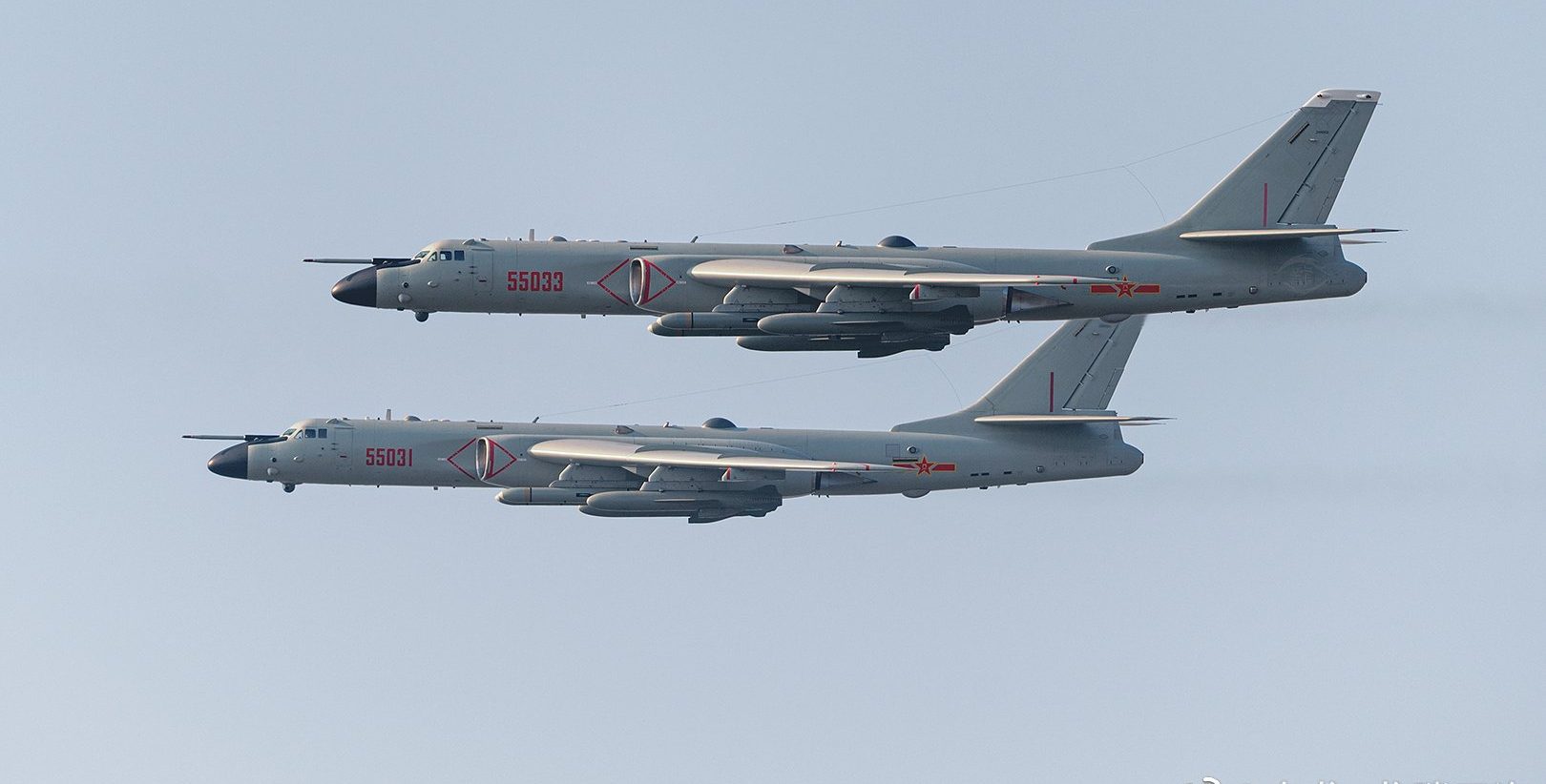
The CJ-10 (up to 2,000 km range) has been chosen as the main land-attack missile for H-6 bombers. Six underwing hard points for CJ-10A cruise missiles were added. The H-6K can carry up to six YJ-12 and 6-7 ALCMs; a single regiment of 18 H-6Ks fully loaded with YJ-12s can saturate enemy ships with over 100 supersonic missiles. The rear 23 mm guns and gunner position are replaced by electronic components.
The H-6K, known in Mainland China as “God of War,” is designed for long-range and stand-off attacks. It is capable of attacking US carrier battle groups and priority targets in Asia. The aircraft has nuclear strike capability, and the variant can be used to launch satellites or ballistic missiles.
The WS-18 (or WS-18A) engine may be intended to re-engine the H-6K. The WS-18 is a reverse-engineered variant of the Russian D-30. The H-6K has had a refueling probe since 2016.
In January 2019, Norinco announced it had tested an equivalent of the American “Mother of all Bombs.” The weapon is carried by an H-6K and takes up the whole of the bomb bay, making it roughly 5–6 m long and weighing 10 tons.
In October 2022, Chinese media showcased the prospective concepts of an H-6K carrying LJ-1 unmanned aerial system conducting drone swarm tactics. LJ-1 was originally designed as a target practice drone with a modular payload that could be modified into a decoy or electronic warfare platform.
H-6 Other Bomber & EW Variants
H-6A was the first Chinese nuclear bomber with a heat-insulated and air-conditioned bomb bay. H-6B is the reconnaissance aircraft. H-6C was the conventional bomber. H-6D, the maritime-strike bomber armed with two air-launched Anti-ship missiles, C-601 (Silkworm) missiles.
The H-6D was equipped with an enlarged radome and a Type 245 Kobalt I-band surveillance radar under the nose. It was later upgraded to carry either two C-301 supersonic anti-ship missiles or four C-101 supersonic anti-ship missiles. An upgraded version capable of carrying four YJ-8 (C-801) anti-ship missiles is currently under development.
The H-6E is a nuclear bomber with an improved countermeasures suite. The H-6F is a conventional bomber with new inertial navigation systems, a Doppler navigation radar, and a GPS receiver.
H-6G provided targeting data to ground-launched cruise missiles. It had no internal bomb bay or defensive armament but carried underwing electronic countermeasures pods.
H-6H was a cruise missile carrier armed with two missiles. H-6J was a modified H-6K for a maritime strike for PLANAF to replace the H-6G. H-6M was a cruise missile carrier with four hard points and a terrain-following system.
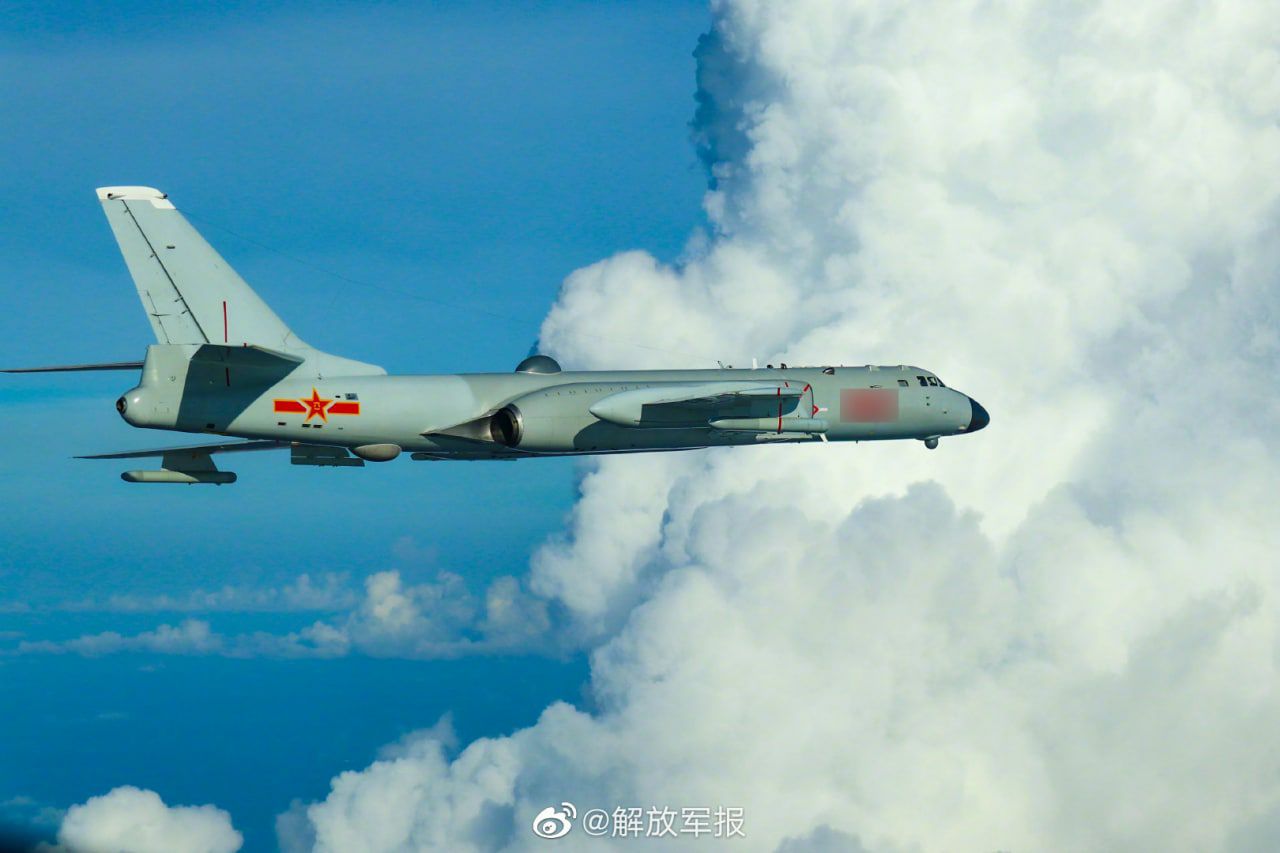
H-6N was a nuclear bomber with an internal bomb bay to carry an air-launched ballistic missile like the CH-AS-X-13, an air-launched variant of the DF-21 anti-ship ballistic missile. HD-6 is an electronic warfare aircraft with a solid nose and canoe fairing believed to contain electronic countermeasures equipment.
The H-6M has four cruise missile pylons and a terrain-following system, but it does not have an internal bomb bay or defensive armament. The H-6 also has a drone launcher variant.
Xi’an H-6MW Bomber
The H-6MW bomber, a specialized cruise missile-carrying variant, has been seen with new air-launched vehicles such as the WZ-8 and MD-22 and a new HSV.
WZ-8 is a supersonic, high-altitude reconnaissance unmanned aerial vehicle (UAV). As per a Janes’ Weekly report, WZ-8 is powered by two liquid-fuelled (possibly hydrazine-based) rocket engines. It has two outward canted fins on the wingtips as well as what appears to be a conformal synthetic aperture radar under its wings and dorsal satellite communication or navigation antennas.
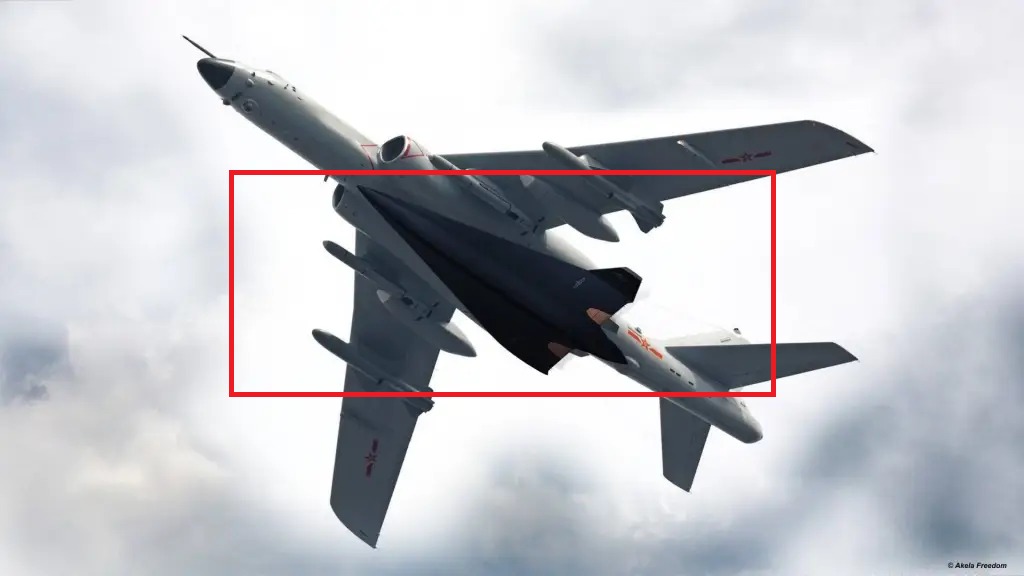
The WZ-8 is operational with the PLAAF’s 30th Air Regiment, operating from an air base near Nanjing.
H-6 Flight Refueler Variants
HY-6 was the first successful in-flight refueling tanker variant in Chinese service. It retained the PV-23 fire control system of H-6 and thus could still be deployed as a missile launcher.
HY-6U was the modified HY-6 tanker with the fire control system and radar deleted and thus became a dedicated refueling aircraft. HY-6D is the Naval Air Refueler that retains missile-carrying and launching capability. HY-6DU is its variant without missiles.
H-6 Operations
The PLAAF (primarily H-6Ks) and PLANAF (primarily H-6Js) use H-6 variants. PLAAF has conventional bomber brigades assigned to the PLA’s Eastern, Southern, and Central Theatre Commands. The nuclear 106th and 23rd Air Brigades are centrally controlled.
H-6s primary operational areas have remained circling around Taiwan and, at times, approaching or violating the airspaces of Japan, South Korea, and the Philippines, and even buzzing US warships.
For years, H-6K bombers were accompanied by other PLAAF military aircraft, such as J-11s, J-16s, Y-8s, Su-30s, KJ-500s, and various UAVs, for incursions into the Taiwanese and sometimes Japanese Air Defense Identification Zones (ADIZ), carrying a variety of payload munitions.
On 13 July 2017, the Japanese Air Self-Defense Force (JASDF) scrambled jets from Okinawa, intercepted, and photographed six Chinese H-6K bombers conducting long-range drills over the Bashi Channel and Miyako Strait through the Taiwanese, East China Sea, and Japanese Air Defense Identification Zones (ADIZ).
Again, on 25 May 2018, the JASDF joined the Taiwanese Air Force’s F-16 fighter jets in intercepting and photographing two H-6K bombers looping around Taiwan Island.
Since 2019, H-6s began joining Russian bombers on “Tokyo Express” patrols, overflying contested islets, triggering responses to a four-way aerial confrontation between fighters from South Korea and Japan.
In a relatively new move, Russian Su-35S and Su-30SM have been seen escorting Chinese H-6K bombers as they made probing flights toward Alaska. The bomber didn’t come closer than 350 kilometers.
The US Air Force (USAF) invariably respondsbyhscrambling its fightersg and trailing the Chinese aircraft. Though the H-6 is a regional range bomber, aerial refueling has allowed it to foray deeper and farther into the Pacific Ocean and make an operational statement to the Americans.
The joint patrols, spurred by common grievances with the United States and its allies, also give the impression that China and Russia are doubling up to magnify their perceived power.
Summarise – H-6 A Useful Asset
The H-6s have a shorter range and lower maximum payload capacity than the B-52 and Tu-95, both of which are of 1950s vintage.
H-6 has a max speed of 1030 kmph and cruises mostly below 800 kmph. Yet the aircraft is useful as a missile-carrying platform that can fire from stand-off ranges without being threatened. H-6 has a significant anti-shipping role.
Most H-6 variants retain bomb bays for gravity-bombing or mine-laying; their important armament is externally carried long-range missiles. The most notable include the heavy YJ-12 supersonic anti-shipping missile, at least two kinds of giant hypersonic air-launched ballistic missiles, and the KD-20/CJ-20 land-attack cruise missile, which also has an anti-ship variant. The H-6 crew can launch these weapons from between 500 kilometers to just over 3,000 kilometers away from their target.
PLAAF currently has nine bomber regiments and two bomber brigades (all with 20 to 30 H-6s each), operating at least six different types of H-6 bombers. It also has an additional regiment of related HD-6 aerial tankers and a training brigade at the Harbin Flight Academy using old H-6A bombers.
China’s very deep arsenal of anti-ship missiles would likely compel US carrier task forces to operate hundreds of miles east of Taiwan beyond the range of most of the missiles. But the US ships and bases could still be well within range of the H-6 bombers’ YJ-12 or YJ-100 missiles that make up the ‘long arm’ of China’s maritime attack capabilities alongside land-based DF-21D and DF-26B anti-ship ballistic missiles.
China will try to isolate Taiwan, including in a pre-hostilities blockade, which might involve long-distance naval mine-laying dropped from H-6Js. China will plan long-distance air strikes against the US airbase at Guam, those at Kadena in Japan, and also those in the Philippines.
They will try to strike front-tier Indian airfields in case of hostilities. The bomber’s near 3,500-kilometre range, combined with the 2,000-kilometre range of KD-20/CJ-10 cruise missiles, results in a deep strike range in oceans. H-6 variants will support aerial refueling and electronic warfare.
To keep the H-6 at a distance deep in its own territory will require long-range surface-to-air missiles such as S-400 and AAMs such as AIM-174B and forthcoming AIM-260 or Russian R-37M and Novator KS-172.
The H-6 has been seen operating from Hotan and Kashgar in Xinjiang, not too far from India’s Ladakh. The H-6K bombers have also operated from the Shigatse air base of Tibet, just 200 kilometers from the Indian border in Sikkim. Despite being an old platform, the H-6 remains a viable and capable bomber in the 21st century. India would have to monitor its positioning and prepare defenses against it.
- Air Marshal Anil Chopra (Retired) is an Indian Air Force veteran fighter test pilot and former Director-General of the Center for Air Power Studies in New Delhi. He has been decorated with gallantry and distinguished service medals while serving in the IAF for 40 years.
- He tweets @Chopsyturvey
- Follow EurAsian Times on Google News

